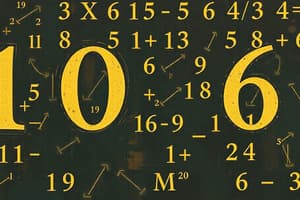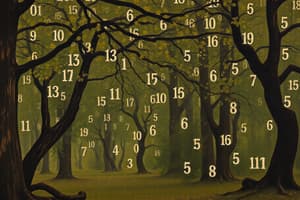Podcast
Questions and Answers
What is the primary purpose of a derivative in calculus?
What is the primary purpose of a derivative in calculus?
- To evaluate limits of functions.
- To identify measures of central tendency.
- To find the area under a curve.
- To determine the rate of change of a function. (correct)
Which of the following concepts is used to describe the spread of a dataset?
Which of the following concepts is used to describe the spread of a dataset?
- Standard deviation (correct)
- Mode
- Median
- Mean
In discrete mathematics, what do sets represent?
In discrete mathematics, what do sets represent?
- Relationships between numbers.
- Connections between different objects.
- Collections of distinct objects. (correct)
- Visual representations of functions.
What is the definition of a prime number?
What is the definition of a prime number?
Which of the following best describes modular arithmetic?
Which of the following best describes modular arithmetic?
What is the process of finding the difference between two numbers called?
What is the process of finding the difference between two numbers called?
Which set of numbers includes all whole numbers and their negative counterparts?
Which set of numbers includes all whole numbers and their negative counterparts?
In which equation type does the general form follow ax² + bx + c = 0?
In which equation type does the general form follow ax² + bx + c = 0?
What do you call a polygon with four sides?
What do you call a polygon with four sides?
Which of the following is not a type of number in the real number system?
Which of the following is not a type of number in the real number system?
What is the amount of space enclosed by a two-dimensional shape called?
What is the amount of space enclosed by a two-dimensional shape called?
Which operation is defined as separating a number into equal parts?
Which operation is defined as separating a number into equal parts?
What is a symbol used to represent an unknown quantity in mathematics?
What is a symbol used to represent an unknown quantity in mathematics?
Flashcards
Limit of a function
Limit of a function
The value a function approaches as its input gets closer and closer to a certain value. It describes the behavior of the function near a specific point.
Derivative
Derivative
The instantaneous rate of change of a function at a specific point. It tells us how fast a function is changing.
Integral
Integral
The accumulation of a function over a certain interval. It represents the area under the curve of a function.
Mean
Mean
Signup and view all the flashcards
Prime number
Prime number
Signup and view all the flashcards
Natural Numbers
Natural Numbers
Signup and view all the flashcards
Whole Numbers
Whole Numbers
Signup and view all the flashcards
Variables in Algebra
Variables in Algebra
Signup and view all the flashcards
Linear Equation
Linear Equation
Signup and view all the flashcards
Quadratic Equation
Quadratic Equation
Signup and view all the flashcards
Perimeter of a Shape
Perimeter of a Shape
Signup and view all the flashcards
Area of a Shape
Area of a Shape
Signup and view all the flashcards
Study Notes
Basic Arithmetic Operations
- Addition: Combining two or more numbers to find their total.
- Subtraction: Finding the difference between two numbers.
- Multiplication: Repeated addition of the same number.
- Division: Separating a number into equal parts.
Number Systems
- Natural numbers (counting numbers): 1, 2, 3, ...
- Whole numbers: Natural numbers and zero (0, 1, 2, 3, ...).
- Integers: Whole numbers and their negative counterparts (... -3, -2, -1, 0, 1, 2, 3, ...).
- Rational numbers: Numbers that can be expressed as a fraction p/q, where p and q are integers and q is not zero.
- Irrational numbers: Numbers that cannot be expressed as a fraction of two integers.
- Real numbers: The set of all rational and irrational numbers.
- Complex numbers: Numbers that include both real and imaginary components, expressed in the form a + bi, where 'a' and 'b' are real numbers and 'i' is the imaginary unit (√−1).
Algebra
- Variables: Symbols used to represent unknown quantities.
- Expressions: Combinations of variables, numbers, and operators.
- Equations: Statements that two expressions are equal.
- Inequalities: Statements that compare two expressions using symbols like <, >, ≤, ≥.
- Solving equations: Finding the value of the unknown variable that makes the equation true.
- Solving inequalities: Finding the range of values of the unknown variable that make the inequality true.
- Functions: Relationships between variables, where each input has a unique output.
- Linear equations: Equations that represent a straight line on a graph.
- Quadratic equations: Equations that can be written in the form ax² + bx + c = 0, where 'a', 'b', and 'c' are constants and 'x' is the variable.
Geometry
- Points: Basic building blocks of geometry.
- Lines: One-dimensional figures that extend infinitely in both directions.
- Planes: Two-dimensional surfaces that extend infinitely in all directions.
- Angles: Formed by two rays sharing a common endpoint.
- Polygons: Closed figures formed by line segments.
- Triangles: Polygons with three sides.
- Quadrilaterals: Polygons with four sides.
- Circles: Set of all points equidistant from a central point.
- Perimeter: The total distance around a two-dimensional shape.
- Area: The amount of space enclosed by a two-dimensional shape.
- Volume: The amount of space occupied by a three-dimensional object.
- Solid shapes: Three-dimensional figures like cubes, spheres, cones, and cylinders.
Calculus
- Limits: The value a function approaches as an input approaches a certain value.
- Derivatives: Rate of change of a function.
- Integrals: Accumulation of a function.
- Applications: Optimization, motion, and modeling.
Statistics
- Data collection: Gathering information.
- Data organization: Arranging information in a meaningful way.
- Data analysis: Interpreting data to draw conclusions.
- Measures of central tendency (mean, median, mode): Representing the central point of a dataset.
- Measures of dispersion (range, standard deviation): Describing the spread of data.
- Probability: The likelihood of an event occurring.
Discrete Mathematics
- Sets: Collections of objects.
- Relations: Connections between objects.
- Functions: Relationships between inputs and outputs.
- Logic: Statements and their truth values.
- Counting principles: Determining the number of possible outcomes.
- Graphs: Visual representation of relationships.
- Trees: Special types of graphs.
- Algorithms: Step-by-step procedures for solving problems.
Number Theory
- Prime numbers: Numbers divisible only by 1 and themselves.
- Divisibility: Relationship between numbers where one is a factor of another.
- Congruence: Comparing the remainders of numbers divided by a divisor.
- Modular arithmetic: Performing arithmetic operations with remainders.
- Diophantine equations: Solving equations with integer solutions.
Studying That Suits You
Use AI to generate personalized quizzes and flashcards to suit your learning preferences.




